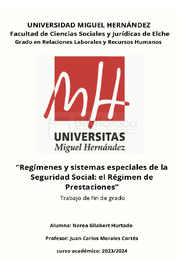Por favor, use este identificador para citar o enlazar este ítem:
https://hdl.handle.net/11000/33227Regímenes y sistemas especiales de la Seguridad Social: el Régimen de Prestaciones

Ver/Abrir:
TFG Regimenes y sistemas especiales de la seguridad social- regimen de prestaciones- NEREA GILABERT HURTADO.pdf
1,34 MB
Adobe PDF
Compartir:
| Título : Regímenes y sistemas especiales de la Seguridad Social: el Régimen de Prestaciones |
| Autor : Gilabert Hurtado, Nerea |
| Tutor: Morales Cortés, Juan Carlos |
| Editor : Universidad Miguel Hernández de Elche |
| Departamento: Departamentos de la UMH::Ciencia Jurídica |
| Fecha de publicación: 2024-06 |
| URI : https://hdl.handle.net/11000/33227 |
| Resumen : El objetivo de este Trabajo de Fin de Grado es el estudio de los diferentes Sistemas y Regímenes Especiales de la Seguridad Social en España. A través de este estudio, se pretende conocer las variedades que existen dentro de nuestro sistema de Seguridad Social y las diferencias que hay entre ellos. Estos regímenes especiales requieren su propia regulación y protección especial para asegurar la plena protección de los trabajadores que los integran, evitando así las desigualdades con aquellos trabajadores que pertenecen al sistema general pero no están incluidos en estos regímenes especiales. Haciendo una búsqueda de sus inicios en el sistema de Seguridad Social, analizando las primeras normativas que los regularon y comparándolos con la actual hemos buscado conseguir una clara idea de cómo han ido evolucionando y adaptando en el tiempo. En España, la aparición de los regímenes y sistemas especiales de la Seguridad Social se sitúa alrededor de la década de 1960 con la promulgación de la Ley de Bases de la Seguridad Social de 1963. Esta ley marcó un hito importante, que sentó las bases para la protección de los trabajadores y sus familias frente a riesgos sociales, desde entonces, los regímenes especiales se han desarrollado y evolucionado en diferentes etapas, respondiendo a las necesidades específicas de diversos colectivos de trabajadores, tales como agricultores, trabajadores del mar, empleados del hogar y autónomos. Se han llevado a cabo medidas para unificar y modernizar tanto el sistema de prestaciones como los regímenes especiales, como integrando algunos de ellos en el Régimen General de la Seguridad Social con un Sistema Especial, pero todavía mucho camino se sigue intentado dar coherencia y eficacia al sistema. Otro análisis que hemos querido realizar en el desarrollo del trabajo ha sido el del Sistema de prestaciones de la Seguridad social, y constituir uno de los pilares más importantes de la protección social de los países. Las prestaciones de la Seguridad Social incluyen una amplia variedad de servicios y beneficios que están diseñados para proporcionar apoyo financiero y asistencia social en situaciones de necesidad, y este sistema de prestaciones de la Seguridad Social está estrechamente relacionado con los Sistemas y Regímenes Especiales de la Seguridad Social, ya que como veremos, están diseñados para atender a colectivos específicos con características particulares. Cada uno de estos regímenes tiene sus propias normativas y condiciones específicas que buscan adaptar las prestaciones a las particularidades de cada grupo. The objective of this Final Degree Project is to study the different Special Systems and Regimes of Social Security in Spain. Through this study, we aim to understand the various components within our Social Security system and the differences among them. These special regimes require their own regulations and special protections to ensure full protection for the workers within them, thus avoiding inequalities compared to those workers who belong to the general system but are not included in these special regimes. By tracing the origins of these special regimes within the Social Security system, analyzing the initial regulations that governed them, and comparing them to the current regulations, we have sought to gain a clear understanding of how they have evolved and adapted over time. In Spain, the emergence of special systems and regimes of Social Security can be traced back to the 1960s with the enactment of the 1963 Social Security Bases Act. This law marked an important milestone, laying the foundation for the protection of workers and their families against social risks. Since then, special regimes have developed and evolved through different stages, responding to the specific needs of various groups of workers, such as farmers, maritime workers, domestic employees, and self-employed individuals. Measures have been taken to unify and modernize both the benefits system and the special regimes, including the integration of some of them into the General Social Security Regime with a Special System. However, much work remains to be done to ensure coherence and efficiency in the system. Another analysis we have undertaken in the development of this project is that of the Social Security benefits system, which constitutes one of the most important pillars of social protection in countries. Social Security benefits include a wide range of services and benefits designed to provide financial support and social assistance in times of need. This benefits system is closely related to the Special Systems and Regimes of Social Security, as they are designed to cater to specific groups with particular characteristics. Each of these regimes has its own regulations and specific conditions aimed at tailoring the benefits to the particularities of each group. |
| Palabras clave/Materias: Sistemas Especiales Regímenes Especiales Seguridad Social Sistema de prestaciones Special Systems Special Regimes Social Security Benefits System |
| Área de conocimiento : CDU: Ciencias aplicadas: Gestión y organización. Administración y dirección de empresas. Publicidad. Relaciones públicas. Medios de comunicación de masas |
| Tipo de documento : info:eu-repo/semantics/bachelorThesis |
| Derechos de acceso: info:eu-repo/semantics/openAccess Attribution-NonCommercial-NoDerivatives 4.0 Internacional |
| Aparece en las colecciones: TFG - Relaciones Laborales y Recursos Humanos |
 La licencia se describe como: Atribución-NonComercial-NoDerivada 4.0 Internacional.
La licencia se describe como: Atribución-NonComercial-NoDerivada 4.0 Internacional.
.png)